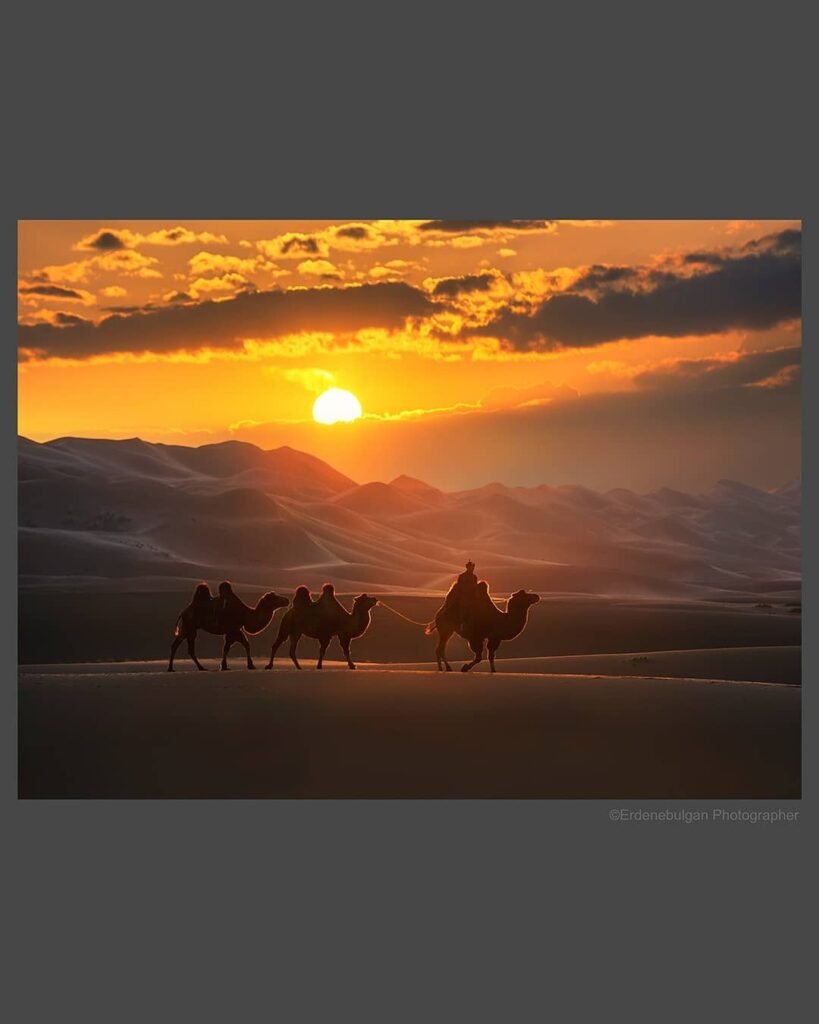Gobi Desert
Mongolia is known for its untouched purity, unspoiled beauty, and seemingly endless landscapes. The Gobi Desert, which encircles Mongolia in a sandy arc from the Nanshan and Altyntag mountains and the Yellow River to the Altai and Tien Shan mountains at the border with China, is the largest natural feature of the nation. The Gobi is astounding in terms of size, covering 1.5 million square kilometers, and there are many unique things to be found there.
The population density here is approximately 0.28 people per square kilometer. This means that you may easily go a few hundred kilometers without coming across a single settlement. A lot of small towns will also be shown on the map, most of them are really migrant camps made up of two or three yurts.
Translated from the Mongolian name of the desert means “waterless place”. For 65 million years of the existence of the Gobi, practically nothing has changed here, except that the wind, bit by bit, shifting the sand dunes, extracts the petrified bones of ancient dinosaurs to the surface.
The remains of prehistoric dinosaurs were found in the Gobi desert in the early 20th century by scientists at the American Museum of Natural History, who were looking for evidence for the theory that Central Asia is the cradle of human civilization. Fossilized bones, dinosaur eggs and their nests have helped to make many discoveries about how these ancient dinosaurs lived and how they raised their offspring.
One of the most stunning deserts in the world, the Gobi is drawn and sculpted by the forces of nature from transparent yellow sands, salt marshes and rocks, vibrating hot air and echoing silence.
However, in part the Gobi desert still remains untouched by man, who did not see him, did not feel the steps of his feet. The border between the two worlds runs along the Nemegetinskaya depression, beyond which there were only specially equipped scientific groups or brave travelers.
The Mongols have a division of the Gobi desert into 33 sectors, although it is difficult for a person who is not familiar with it closely to understand and imagine. 33 small deserts within one huge Gobi differ in types of structure, types of vegetation and colors: there are flowering steppe plains, picturesque rocks, clay and rocky hamads, vast basins, saxaul groves, rare oases, salt marshes and other landscape diversity.
One of the most stunning deserts in the world, the Gobi is drawn and sculpted by the forces of nature from transparent yellow sands, salt marshes and rocks, vibrating hot air and echoing silence. In fact, the sandy part of the Gobi makes up only 3% of the entire desert, the rest of its expanses demonstrate unique landscapes of clay and stone, bewitching landscapes, where many animals and plants also live. Black-tailed gazelles and Gobi brown bears, wolves, saigas and camels live in different parts of the desert – all of them have managed to adapt to the difficult life in the desert. In the Gobi, there are also few places in the world mountain sheep-argali, kulans, gazelles and goitered gazelles.
With its mystique, age that boggles the imagination, the many secrets and legends hidden in it, the Gobi desert attracts brave and enthusiastic travelers from all over the world. Many scientific and research expeditions are equipped here, tourists go on all kinds of transport, from confident and safe jeeps to horses and camels. Thanks to its wild beauty, the preserved traces of the ancient inhabitants of the planet and the ruins of the greatest Mongol Empire, the Gobi remains one of the most important and interesting sights of Mongolia.
https://mongolia-altai-adventure.com/tours-destinations/gobi-desert/
https://en.wikipedia.org/wiki/Gobi_Desert
https://vimeo.com/97659845?embedded=true&source=vimeo_logo&owner=5622568






